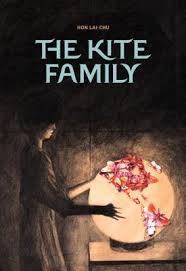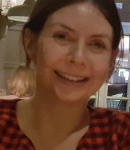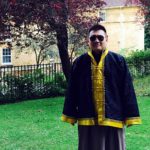The Kite Family by Hon Lai-Chu
Translated by Andrea Lingenfelter

(Muse, 2015)
Publisher's Blurb
A patient escapes from an asylum to spend his life as the perfect mannequin in a store display; a luckless man transforms himself into a chair so people can, literally, sit on him; after living alone is outlawed, a woman who resides quietly with her cat is assigned a role in an artificial “family.”
These are just a few of the inhabitants of Hon Lai-chu’s stories, where surreal characters struggle to carve out space for freedom and individuality in an absurd world. The Chinese version of The Kite Family won the New Writer’s Novella first prize from Taiwan’s Unitas Literary Association, was selected as one of the Top 10 Chinese Novels Worldwide, and was awarded a Translation Grant from the U.S. National Endowment for the Arts.
Reading Chinese Network Reviews
Reviewed by Amy Matthewson, 24/3/19
 When I received The Kite Family, I was immediately attracted to the cover. I thought the book would tell a story of transformation, which is symbolised by the butterflies forming the shape of a world globe. In some ways, my judging the book by its cover was not entirely incorrect.
When I received The Kite Family, I was immediately attracted to the cover. I thought the book would tell a story of transformation, which is symbolised by the butterflies forming the shape of a world globe. In some ways, my judging the book by its cover was not entirely incorrect.
The symbolism of butterflies as agents of change as well as representations of the soul fit Hon Lai-Chu’s six surreal novellas. The twist is that, unlike the positive connotations of butterflies, the changes presented in the stories are not positive and the characters are, in many ways, soulless.
The thread that runs through the collection is a heightened sense of poignancy and loneliness but each story presents a thought-provoking critique of the types of societies we have created along with the expectations and pressures we place on one another. As characters experience a sense of fragmentation and isolation from themselves and those around them, they exhibit cruel or indifferent behaviour.
The Kite Family also brings to mind Shakespeare’s famous verse from As You Like It, “All the world’s a stage, and all the men and women merely players.” The exaggerated performances of Hon Lai-Chu’s characters highlight the idea that life is merely a stage onto which we, as individuals, are expected to perform.
The act of performance becomes increasingly significant in order to maintain modern society. Performances include the role of an immigrant on display (“Spoiled Brains”), as a chair to be used for the comfort of others (“Forrest Woods, Chair”), or specific familial roles (“Notes on an Epidemic”).
Another idea explored in these six novellas is that people, like objects, can be bought and sold according to one’s requirements. In “Heartbreak Hotel,” Amber acquired Clay to keep her company after she lost her home along with the abusive unidentified man she lived with when the tower collapsed. She then put Clay up for sale when she no longer had any use for him.
There appears to be no room for love or compassion in this anxiety-filled, hyper-consumerist modern world. Everyone is replaceable and no one is valued; a sense of worthlessness pervades every story. Hon Lai-Chu’s The Kite Family offers six depressing and bizarre stories and yet, I enjoyed reading this collection. The complexity and multi-layered themes of the stories are relevant and presented within fascinating narratives.
Andrea Lingenfelter’s amazing translation provides richness and depth to each story. I especially appreciated her introduction to the book; this provided me with not only an understanding of how she approached the challenges of translation, but also a clear expectation of style and themes in the following stories.
After completing the book, I returned to the cover with its butterflies. Perhaps the illustration is intended to work together with the text. These stories weave the bizarre and surreal while offering a biting critique of modern society and the soulless citizens it creates. However, the butterflies could be suggesting hope and underscoring the need for change to improve the conditions of our world.
Reviewed by Amy Matthewson
Reviewed by Rebecca Ehrenwirth, 20/3/18
 Hon Lai-chu’s collection of short stories is a subtle critique of contemporary society. The six stories, each stranger than the other, are connected through ironic and sometimes even sarcastic remarks that make the reader want more.
Hon Lai-chu’s collection of short stories is a subtle critique of contemporary society. The six stories, each stranger than the other, are connected through ironic and sometimes even sarcastic remarks that make the reader want more.
The collection is named after the longest story which evolves around an I-narrator and their family with the “Grandmother’s bloated body” (p. 36) in the centre: “Mother told me how Grandmother’s fat kept growing, expanding into the cramped room like some sort of practical joke, so that doctors, nurses, and family members could no longer squeeze in and were forced to examine her from a distance.” (p. 37) The reader soon gets to know that obesity seems to be a family problem. The story is interspersed with horrifying scenes that the I-narrator mentions casually, for instance when Dusty and Zero, two people from the I-narrator’s class, are introduced: Dusty is missing a leg and it turns out that it was Zero who had sawed it off. (p. 43 f.) Everything is connected to the body in one way or the other, and a few pages into the story the reader learns that Grandmother had been hiding things in her stomach: “Uncle and his wife found their long-lost wedding rings, Uncle’s son found his marbles, and there was a half-knitted sweater in there as well” (p. 47). The story’s tone meanders between repulsiveness, sarcasm and clear exaggeration, using a lot of comparisons and similes which add to the vividness. For example, when the Grandmother gets stuck in the door: “The narrow doorframe held her tight as a cork wedged in the neck of a bottle (a situation foreshadowing the pearl necklace that would later block her throat).” (p. 49)
In addition to that, the reader finds subtle critique in the stories by making general statements, for instance: “People can forgive you for not paying attention, but they can’t tolerate when you tell the truth.” (p. 53) In the beginning it is hard to realize why the story is called “The Kite Family” as the obesity seems rather be compared to balloons which are also mentioned in the very first pages. However, throughout the story the reader finds comments like “The thread was nothing but the rule that says people need to be connected” (p. 64) which can refer to a thread of a kite connecting the owner with the object. Another message hidden in this story is that one should stop trying to categorize everything when the I-narrator comes to the conclusion “that identity was a secondary consideration.” (p. 68) Only in the last couple of pages the reader learns about the I-narrator’s sister who is the kite.
There is also the focus on role-playing which can not only be seen in “The Kite Family” but also in “Forrest Woods, Chair” and “Notes on an Epidemic” where it’s emphasized that the characters have to take on roles. In “Forrest Woods, Chair” the reader is kept in the dark for a long time about what Forrest Woods is, whether he is a person or an object. Yet, the boundaries between humans and objects become blurred when a “she” enters the scene: “His [Forest Woods’] arms served as armrests, his feet and lower legs became her footrest, and his flesh reminded her of a soft cushion. […] At that point, Forest Woods didn’t have the slightest interest in what he was; after all, he had been raised since birth to be a human being as a matter of course. When she pointed out what an outstanding chair he was, he felt immeasurably happy.” (p. 111 f.)
The stories concentrate on topics like loneliness (which is seen as a disease in the last story “Notes on an Epidemic”) and individuality; they criticise the superficial character of society and hint to the fact that one shouldn’t take everything just for granted. They include references to the past, like the Great Famine, comment on the present by talking about current living situations as “human storages” (p. 216), and point to the future – “Children are the future pillars of our society.” (p. 152)
Andrea Lingenfelter’s introduction gives a very good overview of what the reader can expect on the following 200 pages and explains some of her decisions for the translation which grasps all the subtleties the text contains.
Reviewed by Rebecca Ehrenwirth
Reviewed by Catherine Shipley, 1/3/18
 Prior to reading this book, were I to be given free reign of a bookshop I would not have selected, The Kite Family, as one of my purchases. I would usually choose a novel over a selection of short stories and I tend to assume that stories which heavily feature surrealism will be frustrating to read. All of this is, of course, simply a matter of personal taste. In spite of this preference, I am glad to have read The Kite Family. I liked the fact that each story offers the reader a distinct, rich experience in its own right. I was taken aback by the wealth of imagination fuelling the narratives. The stories themselves, although surreal, were clearly based on the reality of living in a densely-populated city like Hong Kong.
Prior to reading this book, were I to be given free reign of a bookshop I would not have selected, The Kite Family, as one of my purchases. I would usually choose a novel over a selection of short stories and I tend to assume that stories which heavily feature surrealism will be frustrating to read. All of this is, of course, simply a matter of personal taste. In spite of this preference, I am glad to have read The Kite Family. I liked the fact that each story offers the reader a distinct, rich experience in its own right. I was taken aback by the wealth of imagination fuelling the narratives. The stories themselves, although surreal, were clearly based on the reality of living in a densely-populated city like Hong Kong.
Some of the images portrayed are nightmarish; it is not always pleasant to have them imprinted on your mind. For example, in one story, construction work is taking place in a block of flats and a drill accidentally passes through the wall into a woman’s head. "Front Teeth" features a woman who has too many teeth in her mouth; they sprout from the roof of her mouth and, once pulled out, grow back in force. Such terrible images trigger sensations that allow the reader to better understand characters’ experiences and the atmosphere in which they live their lives. Whether it is anxiety, paranoia, a lack of privacy, questioning the meaning of individuality, hopelessness or even wonder, the sensations featured in the narratives are impossible to ignore.
The powerful images and unexpected turns of event flowing through each short story leave the reader no choice but to turn to the next page out of curiosity. Not all of the imagery is horrific; much is so unique that it is refreshing to discover a new way of looking at familiar topics. I appreciated the dry humour running through the stories. In "Heartbreak Hotel" a character who can barely recall his name is thinking about the challenges of finding employment. His friend reassures him, ‘There will always be demand for a person who has no memory.’
In many ways I felt the book to be a critique of modern living. The characters in each story suffered from isolation, regardless of the people they had around them. Each had their own perspective on events; even characters that had companions did not seem to experience the same reality as those they shared their lives with. Characters also appeared to have a lack of control over their lives; significant events occurred, many of them dramatic, and the characters seemed to passively accept them. It seemed as though they were powerless to change their circumstances.
The narrative is rich and the beauty of such stories is that each reader is likely to have a unique experience of the book and their own interpretation of the meaning of the stories. Reading The Kite Family enabled me to think differently.
Reviewed by Catherine Shipley
Reviewed by Todd Foley, 12/1/18
 I was unfamiliar with Hon Lai-chu before reading The Kite Family, so it was a wonderful surprise for me to discover the six first-rate stories collected in this volume. Depicting the absurdity of contemporary life though nonsensical narratives that focus on the human body and an amorphous array of social and bureaucratic structures, Hon Lai-chu’s work comes off as thoughtful and poignant where it could otherwise be gimmicky, and fresh and innovative where it could otherwise be hackneyed. The stories work well as a collection, and together they present a series of intriguing situations—for example, a man who rents himself out as a chair, and a dentist who is titillated over the “inexhaustible supply of teeth [that] kept popping out” of his patient’s mouth—that offer a productive intervention into questions of the commodification of human life and the postmodern condition in general. While the stories themselves seem more like conceptual experiments that are not necessarily tied to any one particular place (and in fact no specific geographic location is mentioned), the images of Hong Kong that peek through clearly enhance the collection’s major themes of hyperbolic capitalism and the ambiguous power of administrative bureaucracy.
I was unfamiliar with Hon Lai-chu before reading The Kite Family, so it was a wonderful surprise for me to discover the six first-rate stories collected in this volume. Depicting the absurdity of contemporary life though nonsensical narratives that focus on the human body and an amorphous array of social and bureaucratic structures, Hon Lai-chu’s work comes off as thoughtful and poignant where it could otherwise be gimmicky, and fresh and innovative where it could otherwise be hackneyed. The stories work well as a collection, and together they present a series of intriguing situations—for example, a man who rents himself out as a chair, and a dentist who is titillated over the “inexhaustible supply of teeth [that] kept popping out” of his patient’s mouth—that offer a productive intervention into questions of the commodification of human life and the postmodern condition in general. While the stories themselves seem more like conceptual experiments that are not necessarily tied to any one particular place (and in fact no specific geographic location is mentioned), the images of Hong Kong that peek through clearly enhance the collection’s major themes of hyperbolic capitalism and the ambiguous power of administrative bureaucracy.
In several ways, Hon Lai-chu’s writing shares interesting similarities with the work of the Mainland writer Can Xue, although Hon Lai-chu’s stories are generally built upon more graspable foundations than those of the latter. In particular, the completely undependable nature of the human body in the collection’s longest story, “The Kite Family,” calls to mind Can Xue’s 1989 novel Five Spice Street. Can Xue’s novel consists of conflicting accounts of the intriguing yet infinitely enigmatic Madame X: she could be of any age, she is either beautiful or ugly, and she may or may not exist; her husband, at one point, shrivels up into an empty husk on a tree. In “The Kite Family,” the protagonist’s family is afflicted by an exponentially increasing obesity, although her sister is so light that she is able to fly up in the air like a kite during a typhoon, and she later ambiguously alternates between decaying in the freezer and standing naked in front of the window.
Can Xue’s writing, however, is much more intentionally obfuscating than Hon Lai-chu’s, which always provides just enough of a narrative trail to prevent her prose from becoming merely random words spit out by a computer (as one early critic once described Can Xue’s writing). Yet both authors also demonstrate a strict adherence to certain formal structures. For Can Xue, this is demonstrated through the almost mechanical presentation of opposing binaries (photographs versus mirrors, oozing sexuality versus complete chastity, objective verification versus infinite contradiction), while Hon Lai-chu’s formal structure often involves parallel sections of the stories that mirror one another with only an ambiguous relation between them. In "Heartbreak Hotel," for instance, when Amber lived in the BBL Tower before it collapsed, an unidentified man resided in her apartment who verbally abused her and pommeled her with his shoes; after the tower collapses and she moves into the hotel, she purchases another man found in the debris of the tower, installs him in her room, and names him Clay. In “Front Teeth,” the dentist is fixated on Pearl’s ever-increasing excess of teeth, while he also separately recalls the teeth his mother would lose when he was young.
From another angle, Hon Lai-chu is certainly not the first author writing in Chinese to address the theme of human commodification and its attendant loneliness, yet she does so in a way that is brilliantly mundane. In stark contrast to, say, Yu Hua’s characters, who invest in breast implants and reconstructive hymen surgeries in an attempt to get rich, Hon Lai-chu’s protagonists are resigned to a much less bombastic sort of commodified existence. In “Spoiled Brains,” Blanc “lived in a glass-walled suite in a shopping mall” as a display item for a furniture store; Forrest Woods in the eponymous story rents himself out as a human chair; and people are rented out or purchased to be “family members” in both “Heartbreak Hotel” and “Notes on an Epidemic.” The pathetic, quotidian nature of these examples of commodification makes them more sad than shocking, effectively humanizing these otherwise dehumanized characters.
As far as I know, the stories in The Kite Family appear to be the most significant English translation of Hon Lai-chu’s work. Andrea Lingenfelter’s translations are truly superb, and I very much hope there is more to come!
Reviewed by Todd Foley
Reviewed by Cynthia Anderson, 8/1/18
 Hon Lai-Chu’s collection of six stories in The Kite Family is a dystopian take on the absurdity of life in modern Hong Kong. Disorienting in space and time, these stories hint at a world where nameless forces determine what characters can do and Hong Kong itself seems to drift off the page while identity is questioned at every turn.
Hon Lai-Chu’s collection of six stories in The Kite Family is a dystopian take on the absurdity of life in modern Hong Kong. Disorienting in space and time, these stories hint at a world where nameless forces determine what characters can do and Hong Kong itself seems to drift off the page while identity is questioned at every turn.
In the first story, ‘Spoiled Brains’ a migrant, named Blanc, survives being smuggled in a truck, recovers in hospital, then is moved to a shopping mall to live in a glass room where shoppers can observe him. The Manger of the mall advises Blanc to memorize the names of all the shops as the stores will become ‘the coordinates and cardinal directions’ of his life. ‘Blanc realizes that his mother’s role in his life, and his role in hers, when he lived in his old neighborhood beside the public bathroom were astonishingly similar to the role that the shop now played for him.’
In the next story, ‘The Kite Family’, we learn of a grandmother overtaken by unexplained obesity. Construction and drilling into the walls of the narrator’s apartment occurs all day and night and no one knows why or who is responsible. ‘We went out in the morning and came back to an altered apartment every evening…as the days went by, we stopped noticing.’ When the mother and narrator both become obese, connections between family members wither until one day the narrator’s sister nearly flies away in a typhoon. The reader experiences cramped apartments, strange corridors and as the lines between dreams and reality blur, dislocation and questioning of reality and identity rise to the surface.
My favorite story in the collection is ‘Forrest Woods, Chair,’ in which an unemployed man finds solace through becoming an inanimate object. Hon hints at this looming change by a bitter taste in the man’s mouth that steadily increases ‘until he sat down on the floor and assumed the shape of a chair then everything finally calmed down.’ Clearly drawing on Kafka’s Metamorphosis for inspiration, Hon grounds her narrative in the forces bearing down on individual lives in Hong Kong: family pressure to succeed, high living costs, mechanization of work, extreme capitalism. The story is beautifully told, ‘L could still remember the clay-like texture of Forrest Wood’s limbs and face, which reminded her of a dead moth on the wall, the body slowly drying in the air, ultimately transforming into powder that scattered in the wind.’
‘Notes on an Epidemic’, the last story of the collection, is a surreal exploration of an epidemic with echoes of the SARS virus outbreak in 2003. In the story doctors decide that ‘only by strengthening people’s social networks can we stop the spread of viruses.’ New housing equipped with family members is provided for recovering patients and the reader is pulled into a dystopian, unsettling world where ‘what people feared most may not have been death, but rather the prospect of undergoing changes that were beyond their control.’
Andrea Lingenfelter’s translation artfully guides the reader through Hon’s imaginary worlds with clear and concise prose. And her introduction provides crucial grounding in the themes of Hon’s work as well as insight into her role as a translator.
Reviewed by Cynthia Anderson
Reviewed by Barry Howard, 30/12/17
 In this book of surreal fiction, we have a novella – “The Kite Family” – plus five short stories from an author who has won literary awards in her native Hong Kong and in Taiwan. Every tale a challenge to read; comprehension of ideas an occasional hit but mainly miss.
In this book of surreal fiction, we have a novella – “The Kite Family” – plus five short stories from an author who has won literary awards in her native Hong Kong and in Taiwan. Every tale a challenge to read; comprehension of ideas an occasional hit but mainly miss.
Reading the book in content order, first up is “Spoiled Brains”. Fifteen pages later and I wondered what on earth I’d just read, bar some vague idea of a challenge to those who hold contemptuous views of immigrants. In a way it prepares you for the rest of the book by uncoupling you from reality and preparing you for an alternative, discomforting world.
Next is the novella, “The Kite Family”, and straightaway I was thinking back to my experiences of Hong Kong at its worst. Concrete jungle, air pollution, never-ending construction, noise, smells, heat, humidity, lack of space. The story is enveloped by a claustrophobia and a desire, if only for a moment, to get away. I wondered if references to obesity maybe less about actual weight gain and more about how your perceptions of others may change when space is at a premium.
“Forrest Woods, Chair” is the standout story, perhaps because I readily related it to the current phenomenon of work defining who we are as human beings. Mr Woods is unemployed; a status that brings shame on him and his family. However, he thinks up the idea of becoming a chair to provide a personal service –a warm, soft place for busy workers to relax. Consider the pressure to always be (or appear to be) busy; that rest and leisure is only justifiable if it’s as a reward for working hard. Even a snooze can only be obtained guilt-free if it’s paid for – enter the enterprising Mr Woods (shaking off the shackles of conventional wisdom about the jobless).
Just as I thought each tale was becoming easier to get a grip on, “Front Teeth” took me back to square one. Once more, I was having to clutch at possibilities. Perhaps the author wanted to say something about being judged by appearances or about how childhood experiences influence adult behaviours. I looked back at the translator’s introduction for some inspiration and wondered about the brief signposting of ideas for each story; implying concerns about reader comprehension.
“Heartbreak Hotel” represents the whole book. The surrealism shrouds the stories in mist. You can just about make out the themes (here it’s people dealing with the aftermath of their homes being destroyed, domestic abuse, loneliness, worthlessness). Yet the overriding feeling is one of depression. These are stories that not only lack compassion, but are filled with hopelessness.
The book ends with “Notes on an Epidemic”. There are hints of science fiction, but again the overwhelming feeling is one of drudgery. There seems to be a criticism over social pressures to get married and have a family, that living a single life is a disease that needs curing. However, by now, I had run out of patience. The stories seem to require either familiarity with the problematic aspects of a densely populated city like Hong Kong, or to have extensive experience/awareness of the suffering of life; otherwise the reader will be clueless.
Reviewed by Barry Howard
Reviewed by Zahra Raja, 30/12/17
 After having read this collection of short stories for the first time, if I were to say I understood what was going on that would not be entirely truthful. That isn’t to say that it isn’t worth reading or it resists understanding altogether; rather a warning that Hon Lai-chu, a Hong Kong writer, will successfully thwart your attempts to reconcile her stories in a way that makes sense, and if you like disorienting reads that eschew the conventional and scramble your brain, then this is definitely for you.
After having read this collection of short stories for the first time, if I were to say I understood what was going on that would not be entirely truthful. That isn’t to say that it isn’t worth reading or it resists understanding altogether; rather a warning that Hon Lai-chu, a Hong Kong writer, will successfully thwart your attempts to reconcile her stories in a way that makes sense, and if you like disorienting reads that eschew the conventional and scramble your brain, then this is definitely for you.
Hon Lai-chu uses surrealist techniques to write the short stories which is extremely disorienting to the reader; this is when the introduction by Andrea Lingenfelter, the translator of the collection, comes in useful. She argues that Hon’s “primary subject is the absurdity of life in the modern world; while her characters appear to live in world outside of politics…the absurdity and arbitrariness of bureaucracy dogs their every step”. Hon herself is from Hong Kong, and Lingenfelter reminds us to place these stories into the context in which they were written. Since the return of Hong Kong to the mainland in 1999, it is a real fear of Hong Kong residents that China’s one-party state will inevitably reabsorb them back into the mainland and bring about the loss of their very identity. How is an individual to deal with this and move forward in such a society? Identity issues are thus at the heart of these stories.
Bearing these points in mind help the stories yield more meaning than simply taking them at face value. If we take a look at “Forrest Woods, Chair” for example, we see a man who struggles to find his place in society and find a job, which isn’t helped by a highly successful brother and a mother who looks down on him for being unemployed. He discovers a talent in being able to imitate a chair, turns it into a business and eventually, becomes one. Out of the stories in the collection this was by far my favourite because the message was clear and relevant to many. In a world where consumerism is on the rise and employment opportunities at a low, is it possible to retain one’s identity, or even one’s humanity? The outcome of the story is the result of a gradual but inevitable process, as Forrest is unable to cope with pressure both from market forces and his own family.
The eponymous short story “The Kite Family” however leaned much more towards the ‘brain-scrambling’ end of the scale; this is probably due to the fact that it is the longest story in the collection, and nothing seems to progress logically; just as you are lulled into a false sense of security that the story will go where you expect it to, it does a 180-degree backflip and runs in the opposite direction. “The Kite Family” about a family whose women are hereditarily predisposed to becoming obese, and their lives run course seemingly out of their control. This is whilst living in a building that is constantly under construction and having no say as to whether someone should drill a hole into their wall. According to Lingenfelter, there is a sense of “no one is responsible, yet everyone suffers”, and in one particularly absurd scene, someone dies as a result of a builder drilling a hole through the wall and into their head. The family members decide the best course of action is to put the deceased into a fridge and go out to look for the builder who drilled into the wall (who is of course, never found). These people are powerless against the powers that be and their own destinies; there is perhaps a link to mainland China, where there is certainly an epidemic of urban renewal that is forced upon residents whether they agree to it or not, and their lives are often worse off for it despite protest and attempts to block the construction. The authorities exert great influence over their lives though they remain in the shadows.
To sum, something I was guilty of while reading these stories was trying to understand everything too literally rather than enjoying the stories in all of their unconventional, brain-scrambling glory and picking page by page apart rather than trying to understand the overall message the author was trying to convey. Read the introduction and tackle the stories with an open mind and it will make for a much better reading experience.
Reviewed by Zahra Raja
Reviewed by Cuilin Sang, 26/12/17
 In a matter-of-fact tone, Hon Lai-chu’s The Kite Family presents the reader with a kaleidoscope of the strangeness of human body beyond imagination. In these six fantastically grotesque stories, Hon Lai-chu experiments with various possibilities of the corporeal expressions of emotions. Although they are independent stories featuring apparently different characters and storylines, the collection is loosely linked on the level of ambience and psychological overtone. In a way, the whole collection can be read as an extension of Kafka’s The Metamorphosis, only with different transformative violence and psychological and psychiatric nuances. In Hon’s stories, human bodies become highly responsive to the emotional and psychological damage inflicted by society, which is usually run by a state apparatus indifferent to people’s emotional needs. The sense of an ending percolates through each story and persists into the abysmal uncertainty. The phantasmagoric world created by these stories is both familiar and strange. On some level, it is more familiar than strange, which makes it strikingly revealing.
In a matter-of-fact tone, Hon Lai-chu’s The Kite Family presents the reader with a kaleidoscope of the strangeness of human body beyond imagination. In these six fantastically grotesque stories, Hon Lai-chu experiments with various possibilities of the corporeal expressions of emotions. Although they are independent stories featuring apparently different characters and storylines, the collection is loosely linked on the level of ambience and psychological overtone. In a way, the whole collection can be read as an extension of Kafka’s The Metamorphosis, only with different transformative violence and psychological and psychiatric nuances. In Hon’s stories, human bodies become highly responsive to the emotional and psychological damage inflicted by society, which is usually run by a state apparatus indifferent to people’s emotional needs. The sense of an ending percolates through each story and persists into the abysmal uncertainty. The phantasmagoric world created by these stories is both familiar and strange. On some level, it is more familiar than strange, which makes it strikingly revealing.
The collection opens with a story on being forgetful about one’s own body. The protagonist Blanc masters this skill and survives an unimaginably harsh situation. His body becomes immune to being gawked at and his mind to antagonism and xenophobia. It is also this utter lightness of body that brings out the indescribable heaviness in a morbidly efficient society. Hon’s main characters usually either come from disadvantaged social backgrounds, or marginalized positions where their sensitivity won’t affect the efficiency of the society. Sometimes they are “illegal immigrants,” the term vaguely hinting at their mainland China origin. But Hon’s sympathy with the plight of her characters transcends beyond political and territorial boundaries. The names of the cities are deliberately obscured, just like the names of the characters. They are abstracted, but not reduced, to a pure, elemental state. Submerged in a contagious apathy where individuality loses its vigor and appeal, these names with their most pristine forms manage to preserve their existential and resistant edge.
Their body, however, doesn’t take this collective emotional mutation silently. In a surrealistic yet strangely convincing manner, Hon amplifies human body’s ability to record and reflect every injustice and emotional and psychological trauma. In “The Kite Family,” the undiagnosable obesity that runs in the family manifests such documentation and reflection. Different types of invasion from the outside trigger different responses from human body: where stones and jade pearls find their way into the human body and stay hibernated for a considerably long period of time, manmade tools can do instant damage to human existence. The capacity of human body to accommodate certain objects and its frailty to withstand manmade force seem to suggest a fatal severing between human and nature. What remains unsevered is the uncanny connection between human flesh and the trauma/damage it inflicts: such as the one between deformed bodies and noise, or between deformed physiognomy and cruelty.
The rest of this collection continues with this uncanniness. In “Forrest Wood, Chair,” the “decorporealization” of human body from flesh to inanimate objects is linked to environmental deterioration, unemployment rate and personal financial predicament. In the story of teeth, alienated bodies morph into waste spaces as the result of being subject to or contaminated with cruelty. The protagonists are all outcasts for their inability to contribute materially to the society, or for their hazardous physical conditions, as in the case of “Notes on an Epidemic.” Most importantly, though, they are shunned by the society because they can evade to some extent the injustice being done to them and thus make it lose its impact and justification, and also because they are symptomatic of the real epidemic of the society – the increasingly aggravated deficiency in emotional connection.
Hon’s language seems also to be affected by and reflective of this emotional deficiency. Under the pallid, calm surface, words silently mutate into darker, psychological units, disengaged from the horrid reality being depicted by themselves. There is always an indescribable force simmering behind each protagonist’s subservience to his or her fate. Similarly, there is an unassuming, almost clandestine conviction behind the nonchalant, indifferent façade constructed by these words. Hon exploits the polysemy of Chinese language with trust and confidence in the language, letting its emotional pitch freely take root and develop in unfamiliar linguistic situations. All of these qualities have been shrewdly detected and greatly preserved by the translator, Andrea Lingenfelter. Despite all the horrible scenes in her stories, Hon Lai-chu can be an unconventionally optimistic writer. The Kite Family may not be a work of imagination or fantasy. It could be a faithful rendition of a reality revealed through deep seeing and deep feeling. In one way or another, the protagonists continue to survive, and with their marginalized yet persistent existence, they, too, distort the reality of others.
Reviewed by Cuilin Sang
Reviewed by Tamara McCombe, 17/12/17
 Hon Lai-Chu is a much lauded and awarded Hong Kong author. The Kite Family is a collection of short stories titled ‘Spoiled Brains’, ‘Heartbreak Hotel’, ‘The Kite Family’, ‘Front Teeth’, ‘Forrest Woods, Chair’, ‘Notes on an Epidemic’. The Kite Family was first published as a novella and won the New Writer’s Novella first prize from Taiwan’s Unitas Literary Association - the extended version was named one of 2008’s Books of the Year by China Times in Taiwan. Hon has been compared to another female experimental Hong Kong author who was active before her, Xi Xi. A superficial comparison of the authors reveals that both have taught, have written for newspapers and are popular in Taiwan and Mainland China. Literary comparisons with Xi Xi can be seen throughout the short stories contained in The Kite Family which are Kafkaesque in their grotesqueness and surrealism, styles which on a whole I struggle to enjoy, and was the case when reading this collection. The question though is would the social comments Hon is making be as thought provoking if told via realist stories? Most likely not as the reader may quickly take the tales on face value, 'Notes on an Epidemic' for instance may be simply seen as being about a “leftover woman”. Another commonality between the authors can be seen in their use of shops as symbolic of social degradation and generic surroundings. Xi Xi’s story ‘Shops’ romantically illustrates Hong Kong’s past character through ageing buildings, squatters and old-fashioned traditional shops in the Central and Western districts. In 'Spoiled Brains' Hon’s heavy criticism of how the proliferation of international brands has made our environment repetitive and soulless is evident when the store manager says “You need to commit to memory the names of all the shops, so that you won’t get lost. It’s not that hard to do. As you’ll soon discover, from this point on, the same stores reappear in different shopping malls. These are the coordinates and cardinal directions of your life.” 'Spoiled Brains' was the story I could most relate to on account of my professional retail background in a major international brand. Yet these carbon copy stores have been created as a direct result of consumers expecting to have the exact same brand experience and ability to buy the exact same products should they be in the San Francisco or Taipei store. Hon makes an additional social commentary in 'Spoiled Brains' on the pejorative perception and treatment of migrant workers: although pertinent to many countries there was a sense the author was referencing the treatment of Filipino workers in Hong Kong. 'Forrest Woods, Chair' was the story I would say I enjoyed the most. It is the most obvious example of the recurring theme of the physical body being used as an intense psychological reflection of the characters’ inner futile struggles for freedom against the social obligation and search for meaning in everyday existence. Like the characters in the other stories, Forrest in this tale is searching for a “way out” of established social identities by relying on physical transformation. In an attempt to earn money and feel wanted he practices becoming a chair and hiring his services. As part of a generation imprisoned in a social media obsessed world where accruing short-lived ‘likes’ and acknowledgement for manufactured and stylised posts is a constant obligation, this metaphor ran straight home for me. In the introduction, translator Andrea Lingenfelter explains why she chose to translate the character names as opposed to using the Pinyin, a clever painstaking process of balancing literal translations of the Chinese meanings and use of popular Anglophone names – explicitly showing Lingenfelter’s mastery of both the English and Chinese languages. The only issue with opting to translate the names is that by virtue of the translator’s American nationality, she opted for names which might be seen as more common in the US than say Great Britain, Australasia or other English speaking areas. For instance, Forrest is not a name I have heard used outside of America. This potentially imbues the novel with differing cultural connotations depending on the nationality of the reader which may not have been intended by the author in the original.
Hon Lai-Chu is a much lauded and awarded Hong Kong author. The Kite Family is a collection of short stories titled ‘Spoiled Brains’, ‘Heartbreak Hotel’, ‘The Kite Family’, ‘Front Teeth’, ‘Forrest Woods, Chair’, ‘Notes on an Epidemic’. The Kite Family was first published as a novella and won the New Writer’s Novella first prize from Taiwan’s Unitas Literary Association - the extended version was named one of 2008’s Books of the Year by China Times in Taiwan. Hon has been compared to another female experimental Hong Kong author who was active before her, Xi Xi. A superficial comparison of the authors reveals that both have taught, have written for newspapers and are popular in Taiwan and Mainland China. Literary comparisons with Xi Xi can be seen throughout the short stories contained in The Kite Family which are Kafkaesque in their grotesqueness and surrealism, styles which on a whole I struggle to enjoy, and was the case when reading this collection. The question though is would the social comments Hon is making be as thought provoking if told via realist stories? Most likely not as the reader may quickly take the tales on face value, 'Notes on an Epidemic' for instance may be simply seen as being about a “leftover woman”. Another commonality between the authors can be seen in their use of shops as symbolic of social degradation and generic surroundings. Xi Xi’s story ‘Shops’ romantically illustrates Hong Kong’s past character through ageing buildings, squatters and old-fashioned traditional shops in the Central and Western districts. In 'Spoiled Brains' Hon’s heavy criticism of how the proliferation of international brands has made our environment repetitive and soulless is evident when the store manager says “You need to commit to memory the names of all the shops, so that you won’t get lost. It’s not that hard to do. As you’ll soon discover, from this point on, the same stores reappear in different shopping malls. These are the coordinates and cardinal directions of your life.” 'Spoiled Brains' was the story I could most relate to on account of my professional retail background in a major international brand. Yet these carbon copy stores have been created as a direct result of consumers expecting to have the exact same brand experience and ability to buy the exact same products should they be in the San Francisco or Taipei store. Hon makes an additional social commentary in 'Spoiled Brains' on the pejorative perception and treatment of migrant workers: although pertinent to many countries there was a sense the author was referencing the treatment of Filipino workers in Hong Kong. 'Forrest Woods, Chair' was the story I would say I enjoyed the most. It is the most obvious example of the recurring theme of the physical body being used as an intense psychological reflection of the characters’ inner futile struggles for freedom against the social obligation and search for meaning in everyday existence. Like the characters in the other stories, Forrest in this tale is searching for a “way out” of established social identities by relying on physical transformation. In an attempt to earn money and feel wanted he practices becoming a chair and hiring his services. As part of a generation imprisoned in a social media obsessed world where accruing short-lived ‘likes’ and acknowledgement for manufactured and stylised posts is a constant obligation, this metaphor ran straight home for me. In the introduction, translator Andrea Lingenfelter explains why she chose to translate the character names as opposed to using the Pinyin, a clever painstaking process of balancing literal translations of the Chinese meanings and use of popular Anglophone names – explicitly showing Lingenfelter’s mastery of both the English and Chinese languages. The only issue with opting to translate the names is that by virtue of the translator’s American nationality, she opted for names which might be seen as more common in the US than say Great Britain, Australasia or other English speaking areas. For instance, Forrest is not a name I have heard used outside of America. This potentially imbues the novel with differing cultural connotations depending on the nationality of the reader which may not have been intended by the author in the original.
A heavy sense of fatalism runs through all the short stories and is highlighted in The Kite Family by the contrasting use of awkward humour which relieves those readers who may struggle with the gruesome departures from realism which also characterises the story. A chortle issued from my gut at the plight of the grandmother when as a result of genetics her progressively increasing and uncontrollable obesity she is no longer able to buy clothes that fit she is forced to robe herself in curtains. Although no direct reference is made to the setting of the stories, from the mention of tall narrow buildings with repeating rectangular flats, chopsticks, noodles and generic shopping malls, I certainly imagined them, based on my personal travels, taking place in Hong Kong. 'Notes on an Epidemic' certainly resurrected memories of my first trip to Hong Kong which coincided with the outbreak of SARS. The collection of short stories that make up The Kite Family is an interesting exercise of social commentary via non-mainstream literary techniques. Lingenfelter had her work cut out translating this surreal and grotesque text as she could not rely on social norms or assumptions. The translator did a great job of making the surreal more accessible via her choice of smooth rhythm which bears witness to her portfolio of poetry translation. However, I found the obscurity in these stories too gut-wrenching and too distracting to really enjoy this work.
Reviewed by Tamara McCombe
Reviewed by Henry Yunwei Wang, 11/12/17
 Writing this review, intermittently of The Kite Family persistently has taken me over a month: first time for me to win a "Not giving Up Prize" in my reading history. This time it could not be seriously attributed to my cured procrastination, but instead only made it happen again. I was then deeply trapped and defeated in the dystopian lucid dream constructed by Hong Kong writer Hon Lai-chu and her wonderful translator Andrea Lingenfelter. Frankly speaking, surrealistic, unconventional and even "odd" narration style is not my current top favourite, just like not everyone being able to appreciate a masterpiece by van Gogh or Dali, yet, with this masterful collection of stories wildly stretching the limits of everyday imagination, also marked lightly by its fascinating Hong Kong literary landscape, the Kite Family definitely is worth the challenge.
Writing this review, intermittently of The Kite Family persistently has taken me over a month: first time for me to win a "Not giving Up Prize" in my reading history. This time it could not be seriously attributed to my cured procrastination, but instead only made it happen again. I was then deeply trapped and defeated in the dystopian lucid dream constructed by Hong Kong writer Hon Lai-chu and her wonderful translator Andrea Lingenfelter. Frankly speaking, surrealistic, unconventional and even "odd" narration style is not my current top favourite, just like not everyone being able to appreciate a masterpiece by van Gogh or Dali, yet, with this masterful collection of stories wildly stretching the limits of everyday imagination, also marked lightly by its fascinating Hong Kong literary landscape, the Kite Family definitely is worth the challenge.
Born in 1978 in Hong Kong, Hon Lai-chu began writing at the age of ten. Critics have said that she "possesses an innate and precociously odd tactile sense of the world", and "is the most outstanding young author in Hong Kong." Hon finished her first piece of fiction, The Water Pipe Forest, while still in middle school. After graduating from university, she worked for a few years as editor before deciding to devote all herself to independent writing. The Chinese version of The Kite Family showcases Hon's distinctive surreal aesthetic. It won the New Writer's Novella first prize from Taiwan's United Literary Association, was one of 2008's Books of the Year according to Taiwan's China Times, was selected as one of the Top 10 Chinese Novels Worldwide, and the English edition was awarded a Translation Grant from the US National Endowment for the Arts.
Andrea Lingenfelter, the fascinating translator, gives us a solid introduction to HK fiction, story settings and backgrounds, explaining how issues such as market dehumanization, migration, xenophobia, deformity, dysfunction, are presented.
Six stories, neat but not simple per se:
- Spoiled Brains 《壞腦袋》The protagonist Blanc, became an illegal immigrant to get away the suffocating feelings of crowded and being spied on. However, he hadn't ever escaped from this destiny: Being along with loads of rotten tomatoes and dead bodies in a freight truck; Being strictly supervised in an asylum; Earning his living as a mannequin in a department store display. Finally Blanc could only explore his complicated and tangled memory in his mind by "sketching cross-sections of brains."
P.S. In populous HK, space is extremely rare. There are more than 200K citizens who live in wire mesh cages resembling rabbit hutches who name themselves Cagemen 笼民.
- The Kite Family 《風箏家族》 Distinguished in length. A little girl tries to find out the family secret why every member becomes morbidly obese, bigger than the house could fit in adulthood with increasingly bizarre behaviours: Helium balloon-like grandmother consumes most of the family inheritance; Melancholy auntie tears down all her curtains as fabric to make a new gown for meeting a mysterious guest; The only slim sister, vainly tries to drift into the sky like a kite but is drilled on the forehead and killed, by a worker in a tall building.
Insight: If you are interested, watch this German ad that has the coincidental idea of kite boy
EATKARUS – EDEKA Werbung #issso https://www.youtube.com/watch?v=To9COZq3KSo
- Forrest Woods, Chair 《林木椅子》 The most accessible story to me. A man called Forrest Woods, unable to find a job turns himself into a chair so people can sit on him. So that he would proved himself at least worthy to the society. He trains his body to take the form of various types of chairs. In the end, this unfortunate young man literally transforms into a chair.
Insight: If you are interested, watch the following Chinese ad and Argentine animation
爱家,因为家爱我们 https://www.youtube.com/watch?v=3_l5QCnYgc0
EL EMPLEO / THE EMPLOYMENT https://www.youtube.com/watch?v=cxUuU1jwMgM
- Front Teeth 《門牙》A lady who suffers from severe overcrowding of her teeth: "an extraordinarily white and gleaming set of teeth crowded into the swollen tissue of her oral cavity, filling the entire roof of her mouth." Her dentist helps the patient with the obsession with her continuous growing tooth as a business fortune.
- Heartbreak Hotel 《悲傷旅館》 The building collapsed and the survived tenants moved to Heartbreak hotel. A woman, Amber, is struggling to free herself from her memories of her abusive husband. Meanwhile, to fill the inner emptiness and to comfort her anxiety in losing language skills, she bought a homeless man as company but sold him again when she left.
- Notes on an Epidemic 《感冒誌》A disease that targets lonely people has become a deadly epidemic, and a single woman recovering from this influenza caused by living alone is forced to become part of an artificial family in the hope that traditional roles can restore her health. From lonely to numb, then from numb to lonely.
To be honest, the beginning of reading Hon Lai-Chu's work wasn't very pleasant. Forgive me, you might link to persecutory delusion or hysterical depression patient's soliloquies. However, if you were not scared straight away, then you would have the opportunity to have a deeper thinking over those Kafkaesque metamorphoses, metaphors and symbols. Spartans who have killed the dragon could then make acquaintance with the princesses Hon Lai-chu and Andrea Lingenfelter.
In the absurd world, those surreal inhabitants struggle with the author's cautious narration, wildly carving out a space of freedom and individuality. The suggestive issues, unique perhaps to Hong Kong but could also find reflections in any urban society: Government's censorship and abuse of power; obesity and pollution; exploitation of employees; over-emphasis on external beauty; greed, utilitarianism; domestic violence, extramarital affairs; loneliness, selfishness, psychological alienation, family isolation, etc.etc.
Hon Lai-chu drags us into worlds we did not realize were hiding within our own. The borderline between the reality and the illusory worlds that her characters inhabit has paled and been pulled apart. This dazzling writer once said in an interview, "Kafka is not my favorite and I didn't read much of his works. It would be good to have a cup of coffee with him."
For those who want to know more about HK's unique urban culture and features. The HK 2006 thriller Re-cycle 鬼域 may help you to pick up more magic realistic flavour:-
Part 1 https://www.youtube.com/watch?v=pq5bQ-MyMEI
Part 2 https://www.youtube.com/watch?v=ZPCsPjPf6y8
Reviewed by Henry Yunwei Wang
Reviewed by Paul Woods, 7/11/17
 The Kite Family is a collection of six novellas, the longest of which gives its title to the whole book. The stories are different yet exhibit a certain commonality: all are reflections on or responses to a crowded, urban society marked by consumerism and loss of agency. Established conventions are ignored or overturned and the characters struggle for meaning and identity. Some go against the status quo while others learn to live with it.
The Kite Family is a collection of six novellas, the longest of which gives its title to the whole book. The stories are different yet exhibit a certain commonality: all are reflections on or responses to a crowded, urban society marked by consumerism and loss of agency. Established conventions are ignored or overturned and the characters struggle for meaning and identity. Some go against the status quo while others learn to live with it.
The first story, Spoiled Brains, concerns a young illegal immigrant who narrowly escapes death. Locals find immigrants irritating and threatening and commodify them; he is given a job living in a furniture shop, becoming literally ‘part of the furniture’. His is a life on display, that of the obvious ‘other’. The theme of loss of agency continues in The Kite Family, whose members suffer from a genetic predisposition to obesity. The sense of fatalism is compounded by the relentless construction work around them. Internal and external factors determine the suffering and destiny of the unfortunate family members.
The transformation of Forrest Woods marks something of a return to the critique of consumerism of Spoiled Brains. Forrest Woods, Chair is my favourite story in the collection. A man is attracted to the idea of working as and in some way becoming a chair, training physically for the task and setting up a business. Over time, a unidirectional change occurs, his limbs becoming harder and the texture of his skin altering. Eventually, his metamorphosis into a chair is complete.
In Front Teeth a dentist wishes to help Pearl, a woman with serious dental overcrowding, but he also desires her teeth, viewing them as an asset. Pearl suffers discrimination and even loses her job because of her excessive teeth. Like The Kite Family, she is a victim of circumstances beyond her control.
Commodification and consumerism appear again in Heartbreak Hotel. Survivors of a building collapse move to a nearby hotel and find items salvaged from the disaster on sale in the hotel shop, including people. Amber buys a man at the shop and has a curious relationship with him, discovering that they previously shared an apartment.
Finally, Notes on an Epidemic portrays a group of people recovering from a SARS-like virus. Social engineering arranges them into new ‘families’ in which people play roles and can be replaced. As in other stories, people can be bought to perform various tasks.
All the stories convey a sense of fragmentation and contain details which are not integrated into the narrative. The reader gains the feeling of looking through a long tube, seeing only one small part at a time and then only at a distance.
Along with fragmentation come consumerism and exploitation, and many of the characters come across as emotionally cold and indifferent. Possessions are lost, injuries occur, and people die, but these events seem to have little effect on people who are mechanical, almost robotic, and yet somehow natural at the same time.
The adjective ‘Kafkaesque’ has been applied to Hon Lai-chu’s work and the cover of the book talks of Forrest Woods, Chair in terms of Metamorphosis. There is certainly a nightmarish quality to the strange world that Hon creates. For me, probably the most chilling is not the strange episodes that happen but the bland indifference and matter-of-factness with which people respond. This is a parallel universe of alienation and superficiality.
Because there are many competing themes and undeveloped elements I feel that the novellas should be short. In my opinion, The Kite Family story is rather too long, while Spoiled Brains and Forrest Woods, Chair feel about right. Narratives of this length allow the presentation of an idea and the setting up of a plot, whose dystopian contents and signposts disturb and challenge the reader. Longer stories than this require the reader to enter into rather too many rabbit warrens and interact with too many intentionally opaque characters.
As usual, Lingenfelter’s translation is excellent and her translator’s preface is helpful. I sensed some of the cultural hybridity that I felt when reading Jimmy Liao’s The Rainbow of Time, but perhaps more strongly. I had to juxtapose the fact that the author is from Hong Kong and my own familiarity with the city with the justified translation of names like Forrest and Rich and the use of metro rather than MTR. Although the stories do work across cultures, the translation rightly retains the imagery of hot, steamy weather, typhoons, and chopsticks.
Reviewed by Paul Woods.
Reviewed by Andy Thomas, 21/10/17
 Sponsored by the Hong Kong Government, these are new, exciting stories mostly of the Pacific Rim, formed of a collection and a novella, a mixed bag together of various lengths, formatted and printed on an expensive art paper of a larger size. There are colour pictures of author and translator on the front and end covers.
Sponsored by the Hong Kong Government, these are new, exciting stories mostly of the Pacific Rim, formed of a collection and a novella, a mixed bag together of various lengths, formatted and printed on an expensive art paper of a larger size. There are colour pictures of author and translator on the front and end covers.
We know best of author Hon Lai Chu not by a preface in her own hand but one written by her translator, Andrea Lingenfelter. She tackles the rhythms of Chinese and English prose as much as the content of the stories, which flow fast in her translations like a brook between stepping stones.
But I am concerned about the re-naming the Chinese names of the characters when a simple footnote on their derivation would have sufficed. “Forrest” is neither a Chinese nor British name and distracts me from the story “Forrest Woods, Chair” which otherwise is both amusing and scary in a sort of schadenfreude of home furnishings.
Long sentences in The Kite Family are punctuated by drilling in the construction site that is the family home. If I had to sum up the novella in one sentence I’d say that it is about being fat, yea, being obese; smelling and being smelled; concrete and Helium balloons; and the constant drilling by exhausted workmen. But again, the given names “Dusty” and “Zero” do not resonate with me.
And the translation of “Front Teeth”, set in and around a dental practice, occasionally breaks down when they tighten ”the faucet” and not “the tap”, and when “he could hear her sarcastically berating him” in an unusual word order.
“Heartbreak Hotel” is a story about a collapsed tower block and its casualties, made more poignant in its stories of loss by recent events in England. This is a painful story of the impossibility of human life in a residential tower block that collapses, for no reason given, perhaps by its own weight, but certainly a disaster unspecified in blame. Survivors, displaced, form new relationships and then fracture them deliberately and cruelly. I have heard the English name “Amber” adopted by Chinese women but less common is the male name “Clay”.
Finally, while most of these stories could be set anywhere on the Rim, “Notes on an Epidemic” is a short story that stands out because of it authentic scenes from a writers’ notebook, conveying a very mainland Chinese warning about social conformity and suffocating family rôles.
Reviewed by Andy Thomas.
